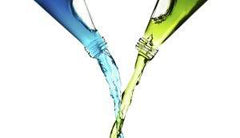The terms freeze point, freeze protection, burst point, and burst protection are often used when discussing the addition of glycol to your HVAC system. What is the difference and how are they determined?
What is the Freeze Point?
The freeze point is the temperature where ice crystals begin to form in the fluid and the fluid becomes slushy, but it does not expand.
What is the Burst Point?
The burst point is the temperature where the fluid will freeze solid, expand, and break pipes or damage coils, fittings, or valves in the system.
What is Freeze Protection?
For freeze protection, the system requires a glycol concentration that is sufficient to prevent the formation of ice crystals at the lowest temperature the system will experience. Freeze protection is important when the system requires pumping. For example, an on-off type snow melt system where the fluid could be sitting in a very low temperature slab and then be called on to be pumped to start the snow melt process. When it is turned on, you do not want to be trying to pump slush.
What is Burst Protection?
For burst protection, the glycol concentration needs to be high enough to prevent bursting or other damage to equipment, but not necessarily high enough to maintain the fluid in a pumpable state. For example, you would need burst protection for a chilled water system that sits dormant in the winter and is exposed to freezing temperatures but the pumps won’t be energized and try to cause the fluid to flow through the system. Burst protection requires less glycol than freeze protection.
In a system with burst protection, as the ambient temperature drops and the fluid cools, ice crystals form and the fluid will become slush. The fluid will expand as ice is formed. We may not be able to pump the slush, but it is fluid enough so that any additional volume will flow into the expansion tank without damage to the piping or components. As it gets colder and all the water freezes the glycol also begins to freeze and contract, again providing the desired burst protection.

How to Know if System Requires Glycol?
The most common uses for glycol in HVAC systems is for snow melt, chilled water, ground source heat pump, and hydronic systems that require protection due to their location, maybe buried in a concrete slab or possibly outside on a roof. Once it is determined that the system needs glycol and what level of protection the glycol needs to provide (either freeze or burst protection), how do we determine the required concentration of glycol?
How to Determine Required Concentration of Glycol?
There are two types of HVAC grade glycols commonly used in our industry, propylene glycol and ethylene glycol. These are not the same thing as the anti-freeze you put into your car’s radiator. Go Glycol Pros™ supplies DOWFROST and DOWFROST HD propylene glycol, and DOWTHERM SR-1 ethylene glycol. There are inherent differences between the propylene and ethylene glycol. Click here to learn more about these two types of glycol. It is important to note that both propylene and ethylene glycol provide the cold temperature protection needed; however, they require different concentration levels to do so. For example, at 10°F DOWTHERM SR-1 ethylene glycol will provide freeze protection with a concentration of about 26% and it provides burst protection at about an 18% concentration. At that same temperature, the system would need a concentration of about 30% DOWFROST HD propylene glycol for the freeze protection and about 21% for burst protection.
To determine what concentration of ethylene or propylene glycol is needed, use our easy concentration calculator. Alternatively, you can utilize the below concentration charts provided by Dow.
Propylene Glycol Freeze Chart

Ethylene Glycol Freeze Chart

Notice in the notation below the charts that minimum concentration levels are recommended to provide adequate corrosion protection and prevent bacterial contamination, both very important items to consider.
You can find and download the DOWFROST, DOWFROST HD and DOWTHERM SR-1 engineering specifications from our material library here.











